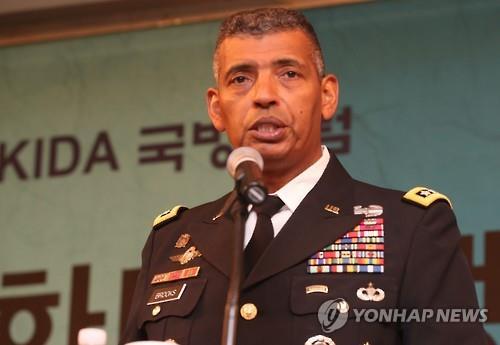The Terminal High Altitude Area defense system will be operated in South Korea in a manner that will pose no health risks to local residents, the commander of U.S. Forces Korea said on Tuesday, amid lingering concerns over the system's powerful radar.
South Korea and the United States announced on July 8 that the advanced anti-missile shield will be set up in the country by the end of 2017, with the allies selecting Seongju, 296 kilometers south of Seoul, as the site for the THAAD battery.
Seongju has the "best possible footprint" for the battery given the locations of military forces in Pyongyang and Seoul, USFK Commander Vincent Brooks said in a seminar hosted by the Korea Institute for Defense Analyses.
Through a series of tests that checked electromagnetic waves emanating from a THAAD radar system in Guam and similar missile defense systems in South Korea, radar waves were found to pose no health problems, but people in Seongju have opted not to accept the findings and have called for the deployment to be scrapped.
South Korea and the United States announced on July 8 that the advanced anti-missile shield will be set up in the country by the end of 2017, with the allies selecting Seongju, 296 kilometers south of Seoul, as the site for the THAAD battery.
Seongju has the "best possible footprint" for the battery given the locations of military forces in Pyongyang and Seoul, USFK Commander Vincent Brooks said in a seminar hosted by the Korea Institute for Defense Analyses.
Through a series of tests that checked electromagnetic waves emanating from a THAAD radar system in Guam and similar missile defense systems in South Korea, radar waves were found to pose no health problems, but people in Seongju have opted not to accept the findings and have called for the deployment to be scrapped.

In response to their anger, Brooks reiterated his earlier position towards local worries about health risks involving a THAAD system.
"When it comes to safety in and around the radar system, no one will be closer to that radar than my soldiers under my command. I would not recklessly endanger those soldiers while they are protecting someone else," he pointed out.
These facts need to be explained to the general public and the local residents of Seongju so they can accept the planned THAAD deployment, Brooks said.
He was confident about the safety of the system, saying he has been involved in placing four different systems in three different countries over the past five years.
The four-star general then said that since there can never be any government decision that satisfies all related people or parties, there should be dialogue between the authorities and the affected people so as to narrow differences.
As for the protection of Seoul and metropolitan areas around the capital city, the commander who also serves as commander of the United Nations Command and Combined Forces Command in South Korea, said there should be other capabilities to protect the areas as the THAAD system is part of a broader aerial defense system to counter missile threats from North Korea.
"THAAD is a part of a layered missile defense system. We will continue to procure Patriot PAC-3 advanced missiles to further enhance defense of layers (to protect Seoul and metropolitan areas). And our pursuit of surface and sea-based interceptors also add layers of defense to incoming missiles," he said.
Seoul plans to gradually replace its Patriot PAC-2 anti-missile system with a more lethal PAC-3 system by 2018 to better counter incoming missiles from the North. The PAC-3s are dedicated anti-missile systems, while the PAC-2s is primarily aimed at engaging aircraft. (Yonhap)
"When it comes to safety in and around the radar system, no one will be closer to that radar than my soldiers under my command. I would not recklessly endanger those soldiers while they are protecting someone else," he pointed out.
These facts need to be explained to the general public and the local residents of Seongju so they can accept the planned THAAD deployment, Brooks said.
He was confident about the safety of the system, saying he has been involved in placing four different systems in three different countries over the past five years.
The four-star general then said that since there can never be any government decision that satisfies all related people or parties, there should be dialogue between the authorities and the affected people so as to narrow differences.
As for the protection of Seoul and metropolitan areas around the capital city, the commander who also serves as commander of the United Nations Command and Combined Forces Command in South Korea, said there should be other capabilities to protect the areas as the THAAD system is part of a broader aerial defense system to counter missile threats from North Korea.
"THAAD is a part of a layered missile defense system. We will continue to procure Patriot PAC-3 advanced missiles to further enhance defense of layers (to protect Seoul and metropolitan areas). And our pursuit of surface and sea-based interceptors also add layers of defense to incoming missiles," he said.
Seoul plans to gradually replace its Patriot PAC-2 anti-missile system with a more lethal PAC-3 system by 2018 to better counter incoming missiles from the North. The PAC-3s are dedicated anti-missile systems, while the PAC-2s is primarily aimed at engaging aircraft. (Yonhap)


















